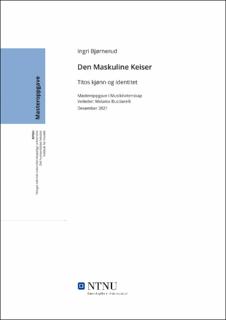| dc.description.abstract | Denne masteroppgaven er en musikkvitenskaplig oppgave som utforsker hvordan en tolkning av Wolfgang Amadeus Mozarts la Clemenza di Tito (1791), basert i et kjønnsperspektiv belyser operaen på nye måter, og skaper større helhetlig forståelse. Mer spesifikt er dette en analyse av operaens tittelrolle, Tito, som en maskulin figur. Målet er å illustrere hvorfor det er viktig å analysere mannlige karakterer som spesifikt maskuline.
Første del av oppgaven består i å skape et teoretisk grunnlag for denne analysen. Her kontekstualiseres operaen i sin samtid. Politiske, religiøse og filosofiske forhold legges i bunn, men hovedsakelig fokuseres det på kjønnsroller på 1700-tallet, og hvordan disse skiftet. To viktige aspekter å trekke fram her er sosiale forhold mellom menn og kjønnsroller i operaproduksjon. Moderne kjønnsteori inkorporeres også, noe som skaper en ramme for tolkning og en linse å se operaen gjennom. Til sist går oppgaven spesifikt inn på Titos karakter, hvordan han ble til og hva som påvirket denne tilblivelsen.
Andre del av oppgaven er en analysedel. Denne består først av en karakteranalyse av Tito, av hans karakter gjennom hele operaen, hans rolle, karaktertrekk og konflikter. Deretter analyseres en mer spesifikk del av operaen: akt 2 scene 5-12. I dette utdraget av operaen testes Tito til det ytterste og dette er kanskje de mest definerende scenene for hans karakter. Her analyseres tekst og musikk sammen for å komme nærmere inn på Titos karakter. Særlig samspillformer, instrumentering, harmonier og horisontale linjer er viktig for analysen.
Etter dette diskuteres funnene, og trådene i oppgaven trekkes sammen. Her kommer det fram aspekter av operaen, og særlig Tito som karakter, som man ikke ville hatt innsyn i uten kjønnsperspektivet og uten å fokusere på det maskuline. I konklusjonen legges disse aspektene fram klart og tydelig. | |
| dc.description.abstract | This master's thesis is a musicological thesis that explores how an interpretation of Wolfgang Amadeus Mozart's la Clemenza di Tito (1791), based on a gender perspective, illuminates the opera in new ways, and creates greater overall understanding. More specifically, this is an analysis of the opera's title role, Tito, as a masculine figure. The aim is to illustrate why it is important to analyze male characters as specifically masculine.
The first part of the thesis consists of creating a theoretical basis for this analysis. Here the opera is contextualized in its time. Political, religious and philosophical issues are the fundament, but the main focus is on gender roles in the 18th century, and how these changed. Two important aspects to highlight here are social relations between men and gender roles in opera production. Modern gender theory is also incorporated, which creates a framework for interpretation and a lens to see the opera through. Finally, the thesis deals specifically with Tito's character, how he came to be and what influenced this creation.
The second part of the thesis is mainly analysis. First, this consists of a character analysis of Tito, of his character throughout the opera, his role, character traits and conflicts. Then a more specific part of the opera is analyzed: act 2 scene 5-12. In this excerpt of the opera, Tito is tested to the limit and these are perhaps the most defining scenes for his character. Here, text and music are analyzed together to get closer to Tito's character. Particular forms of musical interaction, instrumentation, harmonies and horizontal lines are important for the analysis.
After this, the findings are discussed, and the threads of the thesis are pulled together. Here we find emerging aspects of the opera, and especially Tito as a character, which one would not have had insight into without the gender perspective and without focusing on the masculine. In the conclusion, these aspects are presented clearly and distinctly. | |
